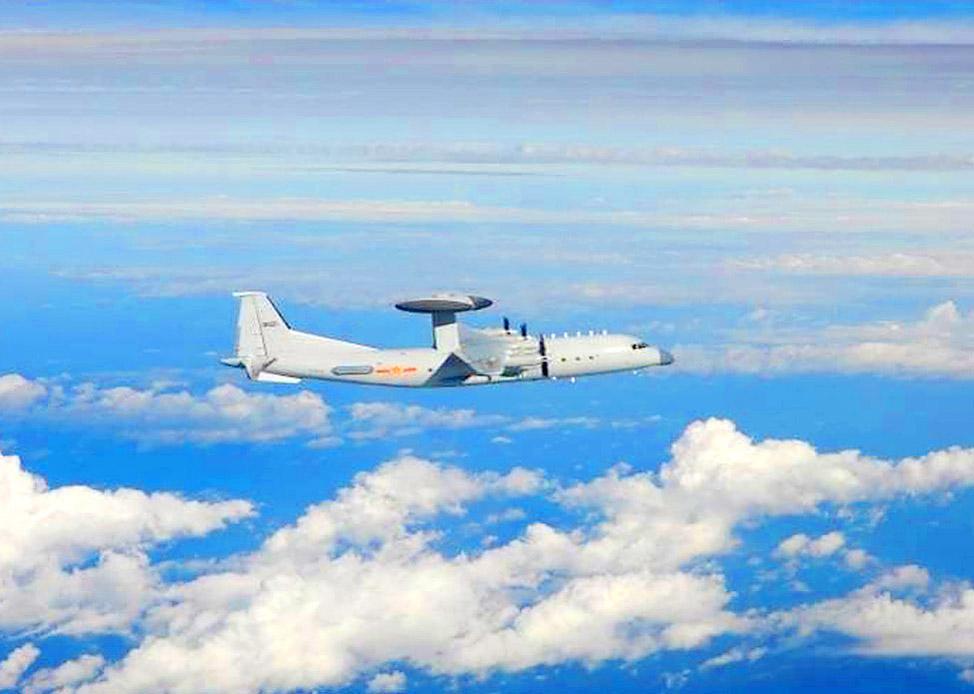The Ministry of National Defense yesterday said that it is combating Chinese Communist Party (CCP) cognitive warfare efforts against Taiwan.
The ministry said it has submitted guidelines to the Legislative Yuan to define cognitive warfare efforts by foreign powers and to outline the military’s actions to combat it.
China’s use of social media and other platforms to spread disinformation and cause social unrest in Taiwan has been increasing, it said.

Photo: EPA-EFE / the Ministry of National Defense
The CCP engages in cognitive warfare with Taiwan through the use of propaganda, fake social media accounts, content farms and Taiwanese collaborators, it said.
The military traces misinformation shared through social media in Taiwan, and posts corrected information on its own social media accounts and Web sites, the ministry said, adding that it also posts the corrected information in replies to public posts where possible.
Meanwhile, a defense researcher on Saturday said that the military must continue to improve its asymmetric combat and electronic warfare capabilities to meet the threat of a Chinese invasion attempt.
Institute for National Defense and Security Research senior analyst Su Tzu-yun (蘇紫雲) was responding to an investigative report titled “T-Day: The Battle for Taiwan,” published by Reuters on Friday.
The possible scenarios regarding a Chinese attack discussed in the report have all been previously discussed between the ministry and US officials at the Pentagon, he said.
The article described six scenarios, including a Chinese blockade of Lienchiang County, an invasion of Kinmen County, a customs quarantine, a full blockade, an air and missile campaign, and an all-out invasion of Taiwan.
In each of the scenarios, China’s goal is to force Taipei into unification negotiations, which Taipei refuses in every scenario, instead appealing to the US, Japan and Australia for assistance.
“Reuters has said that Taiwan’s reserve forces are too weak, and this is an area the military is working to strengthen,” he said.
Su cited the report as saying that Taiwan would counter a Chinese attack with missiles, but that the number of missiles it has is limited.
“However, if Taiwan is able to secure Harpoon anti-ship missiles from the US, that would change the situation,” he said.
Citing a statement by Minister of National Defense Chiu Kuo-cheng (邱國正) in a letter to the Wall Street Journal that was published on Thursday, Su said that “Taiwan is no match for China in resources, manpower or military technologies.”
However, Taiwan has the will and determination to defend itself, so it must speed up investment in its asymmetric warfare capabilities to tip the scales in its favor in the event of a conflict in the Taiwan Strait, he said.
“Taiwan should also play to its strengths in information technology, and invest more in its electronic warfare capabilities,” he said. “This is an area that China has been investing in recently, so Taiwan needs to keep pace.”
Su said that an estimated 18 percent of Chinese military planes that have flown near Taiwan’s waters in the past year were electronic warfare aircraft.
This showed that China was seeking to emulate tactics used by the US military, such as the use of its Suter software that allows it to monitor and control enemy air-defense systems, he said.
To counter this, Taiwan must improve the encryption of its wireless communications and develop heterogeneous communications systems, he said.

ACTION PLAN: Taiwan would expand procurement from the US and encourage more companies to invest in the US to deepen bilateral cooperation, Lai said The government would not impose reciprocal tariffs in retaliation against US levies, President William Lai (賴清德) said yesterday, as he announced five strategies to address the issue, including pledging to increase Taiwanese companies’ investments in the US. Lai has in the past few days met with administrative and national security officials, as well as representatives from various industries, to explore countermeasures after US President Donald Trump on Wednesday last week announced a 32 percent duty on Taiwanese imports. In a video released yesterday evening, Lai said that Taiwan would not retaliate against the US with higher tariffs and Taiwanese companies’ commitments to

Intelligence agents have recorded 510,000 instances of “controversial information” being spread online by the Chinese Communist Party (CCP) so far this year, the National Security Bureau (NSB) said in a report yesterday, as it warned of artificial intelligence (AI) being employed to generate destabilizing misinformation. The bureau submitted a written report to the Legislative Yuan in preparation for National Security Bureau Director-General Tsai Ming-yen’s (蔡明彥) appearance before the Foreign Affairs and National Defense Committee today. The CCP has been using cognitive warfare to divide Taiwanese society by commenting on controversial issues such as Taiwan Semiconductor Manufacturing Co’s (TSMC, 台積電) investments in the

HELPING HAND: The steering committee of the National Stabilization Fund is expected to hold a meeting to discuss how and when to utilize the fund to help buffer the sell-off The TAIEX plunged 2,065.87 points, or 9.7 percent, to close at 19,232.35 yesterday, the highest single-day percentage loss on record, as investors braced for US President Donald Trump’s tariffs after an extended holiday weekend. Amid the pessimistic atmosphere, 945 listed companies led by large-cap stocks — including Taiwan Semiconductor Manufacturing Co (TSMC, 台積電), Hon Hai Precision Industry Co (鴻海精密) and Largan Precision Co (大立光) — fell by the daily maximum of 10 percent at the close, Taiwan Stock Exchange data showed. The number of listed companies ending limit-down set a new record, the exchange said. The TAIEX plunged by daily maxiumu in just

‘COMPREHENSIVE PLAN’: Lin Chia-lung said that the government was ready to talk about a variety of issues, including investment in and purchases from the US The National Stabilization Fund (NSF) yesterday announced that it would step in to staunch stock market losses for the ninth time in the nation’s history. An NSF board meeting, originally scheduled for Monday next week, was moved to yesterday after stocks plummeted in the wake of US President Donald Trump’s announcement of 32 percent tariffs on Taiwan on Wednesday last week. Board members voted to support the stock market with the NT$500 billion (US$15.15 billion) fund, with injections of funds to begin as soon as today. The NSF in 2000 injected NT$120 billion to stabilize stocks, the most ever. The lowest amount it